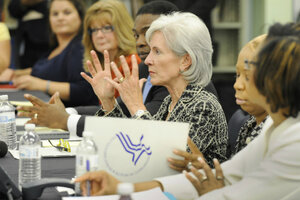Touting Obamacare, US says millions could pay less than $100 a month
A report by HHS says 56 percent of uninsured could pay $100 or less (or nothing) for health coverage. Enrollment opens on Oct. 1, but public resistance to Obamacare is stronger than ever.

Health and Human Services Secretary Kathleen Sebelius addressed local health-care providers and community leaders on details of the soon-to-be-implemented Affordable Care Act, during a visit to Jacksonville, Florida's Sulzbacher Center on Monday.
Bob Self/The Florida Times-Union, Bob Self/AP
Washington
Millions of Americans are about to discover the deal Uncle Sam is offering for health insurance: tax subsidies that bring the cost of coverage down to less than $100 a month.
Under Obamacare, an estimated 21.9 million uninsured Americans will be eligible to purchase subsidized health insurance via online marketplaces, which begin enrollment Oct. 1. Of those, nearly half – 10.8 million – may be able to buy insurance for $100 or less per month, after factoring in tax credits, according to a report issued Tuesday by the Department of Health and Human Services (HHS).
An additional 12.4 million uninsured Americans will be newly eligible for either Medicaid or the Children’s Health Insurance Program, federal-state health-insurance programs for low-income people, the report says. This group will pay either a small premium or nothing.
“The health-care law is making health insurance more affordable,” HHS Secretary Kathleen Sebelius said in a statement.
The report’s release, two weeks before the Oct. 1 launch of the marketplaces, comes as part the Obama administration’s efforts to heighten awareness and acceptance of the 2010 Patient Protection and Affordable Care Act (ACA), Obamacare’s formal title.
The challenge is daunting: Nearly 40 percent of those without insurance polled by USA Today/Pew Research Center said they did not know that the law requires them to get health insurance next year. Among young adults, whom the administration is counting on to participate, only 56 percent know that buying insurance is mandatory or else they will face a fine.
The USA Today/Pew poll, released Monday, found opposition to Obamacare at an all-time high, 53 percent, with 42 percent supporting it. Moreover, uninsured Americans – a main target of the legislation – are about as likely to disapprove as approve it. Nearly a third of the uninsured (32 percent) say that the law will have a positive effect, while as many (33 percent) say that the impact will be negative.
Congressional Republicans have worked hard to demonize the president’s health-care reform, and have voted more than 40 times to repeal it. Some tea party-oriented members are threatening to allow the government to shut down when the federal fiscal year ends Sept. 30, if Obamacare is not defunded.
A pro-Obama group, Enroll America, is reaching out to various segments of the population to sell the reform and boost awareness, as Oct. 1 approaches.
A large uninsured population has dogged the nation for decades – a combination of people who can’t afford insurance but earn too much to qualify for Medicaid; people with health conditions that have made them uninsurable; and people who choose to go uninsured. Obamacare bans excluding from coverage people with preexisting conditions.
On Tuesday, the Census Bureau reported that between 2011 and 2012, the percentage of the US population that lacks health insurance declined only slightly – from 15.7 percent to 15.4 percent. In 2012, 48 million people lacked coverage, compared with 48.6 million in 2011.
According to HHS, of the 41.3 million individuals who are uninsured and eligible for a federal coverage benefit, more than half – 56 percent – may qualify for Medicaid, CHIP, or tax credits to buy coverage for $100 per month or less.
Still, the administration faces a math problem: The fine for lack of compliance can be as low as $95 for all of 2014, the first year of the program – far less than the cost of coverage. In subsequent years, the fines will increase, but won’t equal or exceed the cost of coverage to those above a certain income level. Some people object to a government mandate that requires them to buy insurance; others, especially healthy 20-somethings dubbed “young invincibles,” are willing to take their chances without insurance and save money.
Experts on health law argue that those up-front savings could be penny-wise and pound-foolish.
“People buy health insurance for stability, making sure they aren’t bankrupted by a car accident or heart attack,” Timothy Jost, a law professor who studies health policy at Washington and Lee School of Law in Lexington, Va., tells Politifact.com. “For a lot of those people, they’re going to decide they’d rather pay a bit more for insurance and have something than pay the penalty and be uninsured.”
Another source of frustration for the Obama administration is the decision by about half the states to opt out of the law’s expansion of Medicaid eligibility, which the Supreme Court said they had the right to do in its 2012 ruling that upheld the bulk of the law.
The HHS report released Tuesday assumes in its data that 25 states and the District of Columbia will expand their Medicaid programs. On Monday, another state – Pennsylvania – took a step toward acceptance of expanded Medicaid. Gov. Tom Corbett (R) said he would take up the federal government’s offer of additional money for expanded Medicaid eligibility, amounting to billions of dollars, if he could use it to buy private insurance policies rather than expand a health-care entitlement. Some 520,000 people would benefit.
Under Governor Corbett’s plan, Medicaid recipients would have to be either looking for work or participating in job training. No other state has that requirement.

